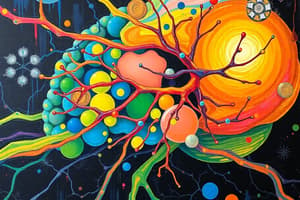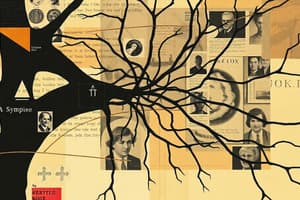Podcast
Questions and Answers
Which of the following is NOT a key element of the nervous system's functioning mentioned in the content?
Which of the following is NOT a key element of the nervous system's functioning mentioned in the content?
- Action Potentials
- Receptors
- Hormonal Signaling (correct)
- Synaptic Transmission
What is the function of a synapse?
What is the function of a synapse?
- To provide structural support for neurons
- To generate action potentials in neurons
- To store neurotransmitters
- To facilitate communication between neurons or a neuron and a target cell (correct)
What is the difference between an axodendritic synapse and an axosomatic synapse?
What is the difference between an axodendritic synapse and an axosomatic synapse?
- Axodendritic synapses are inhibitory, while axosomatic synapses are excitatory.
- Axodendritic synapses are located between the axon and the cell body, while axosomatic synapses are located between the axon and the dendrite. (correct)
- Axodendritic synapses are more common than axosomatic synapses.
- Axodendritic synapses are involved in learning and memory, while axosomatic synapses are involved in sensory processing.
Which of the following is NOT a characteristic of electrical synapses?
Which of the following is NOT a characteristic of electrical synapses?
What is the role of neurotransmitters in chemical synapses?
What is the role of neurotransmitters in chemical synapses?
What is the effect of an inhibitory neurotransmitter on the postsynaptic neuron?
What is the effect of an inhibitory neurotransmitter on the postsynaptic neuron?
How does the presence of a receptor affect the action of a neurotransmitter?
How does the presence of a receptor affect the action of a neurotransmitter?
What is the main function of synaptic vesicles?
What is the main function of synaptic vesicles?
Why is it important to remove neurotransmitters from the synaptic cleft?
Why is it important to remove neurotransmitters from the synaptic cleft?
Which of the following is involved in the removal of neurotransmitters?
Which of the following is involved in the removal of neurotransmitters?
What is the primary difference between electrical and chemical synapses?
What is the primary difference between electrical and chemical synapses?
Which of the following is NOT a way in which neurotransmitters are removed from the synaptic cleft?
Which of the following is NOT a way in which neurotransmitters are removed from the synaptic cleft?
Which type of neurotransmitter receptor directly opens ion channels upon binding?
Which type of neurotransmitter receptor directly opens ion channels upon binding?
Which of the following ions contribute to the generation of an Excitatory Postsynaptic Potential (EPSP)?
Which of the following ions contribute to the generation of an Excitatory Postsynaptic Potential (EPSP)?
What is the primary function of the membrane-spanning domain in an ionotropic receptor?
What is the primary function of the membrane-spanning domain in an ionotropic receptor?
Which of the following neurotransmitters utilizes ionotropic receptors?
Which of the following neurotransmitters utilizes ionotropic receptors?
How does the activation of a G protein by a GPCR indirectly activate ion channels?
How does the activation of a G protein by a GPCR indirectly activate ion channels?
Which of the following is NOT a characteristic of metabotropic receptors?
Which of the following is NOT a characteristic of metabotropic receptors?
Which of these statements accurately describe Inhibitory Postsynaptic Potentials (IPSPs)?
Which of these statements accurately describe Inhibitory Postsynaptic Potentials (IPSPs)?
What does the term 'graded' refer to in the context of postsynaptic potentials?
What does the term 'graded' refer to in the context of postsynaptic potentials?
What is the role of the effector in a metabotropic receptor signaling pathway?
What is the role of the effector in a metabotropic receptor signaling pathway?
What is the main principle behind summation in postsynaptic neurons?
What is the main principle behind summation in postsynaptic neurons?
The binding of a neurotransmitter to its receptor initiates which of the following?
The binding of a neurotransmitter to its receptor initiates which of the following?
Which of the following is NOT a common ion that can pass through ion channels associated with ionotropic receptors?
Which of the following is NOT a common ion that can pass through ion channels associated with ionotropic receptors?
What is the main difference between the speed of ionotropic and metabotropic receptors?
What is the main difference between the speed of ionotropic and metabotropic receptors?
What happens to the G protein when a ligand binds to the receptor?
What happens to the G protein when a ligand binds to the receptor?
What is the primary role of the bg subunits in the G protein signaling pathway?
What is the primary role of the bg subunits in the G protein signaling pathway?
What is the role of GTPase activity in the a subunit of the G protein?
What is the role of GTPase activity in the a subunit of the G protein?
What is the consequence of the a subunit binding to the effector in the G protein signaling pathway?
What is the consequence of the a subunit binding to the effector in the G protein signaling pathway?
What happens to the G protein after the effector is activated?
What happens to the G protein after the effector is activated?
What is the difference between GPCRs that directly activate ion channels and those that use G proteins?
What is the difference between GPCRs that directly activate ion channels and those that use G proteins?
Which of the following is a common effector protein activated by the a subunit of the G protein?
Which of the following is a common effector protein activated by the a subunit of the G protein?
Which of these processes is essential for the re-formation of the inactive trimeric G protein?
Which of these processes is essential for the re-formation of the inactive trimeric G protein?
What is the role of the K+ channels in GPCR signaling?
What is the role of the K+ channels in GPCR signaling?
What is the main difference between the G protein signaling pathway and the direct ion channel activation pathway?
What is the main difference between the G protein signaling pathway and the direct ion channel activation pathway?
Flashcards
Synaptic Transmission
Synaptic Transmission
The process by which neurotransmitters are released from one neuron to communicate with another.
Neurotransmitters
Neurotransmitters
Chemical substances that transmit signals across a synapse from one neuron to another.
Receptors
Receptors
Proteins on the postsynaptic cell membrane that neurotransmitters bind to, initiating a response.
Postsynaptic Potentials
Postsynaptic Potentials
Signup and view all the flashcards
Chemical Synapse
Chemical Synapse
Signup and view all the flashcards
Excitatory Neurotransmitters
Excitatory Neurotransmitters
Signup and view all the flashcards
Inhibitory Neurotransmitters
Inhibitory Neurotransmitters
Signup and view all the flashcards
Action Potential
Action Potential
Signup and view all the flashcards
G Protein Activation
G Protein Activation
Signup and view all the flashcards
Excitatory Postsynaptic Potential (EPSP)
Excitatory Postsynaptic Potential (EPSP)
Signup and view all the flashcards
Inhibitory Postsynaptic Potential (IPSP)
Inhibitory Postsynaptic Potential (IPSP)
Signup and view all the flashcards
Summation at Postsynaptic Neuron
Summation at Postsynaptic Neuron
Signup and view all the flashcards
Synapse
Synapse
Signup and view all the flashcards
Presynaptic Neuron
Presynaptic Neuron
Signup and view all the flashcards
Postsynaptic Neuron
Postsynaptic Neuron
Signup and view all the flashcards
Axodendritic Synapse
Axodendritic Synapse
Signup and view all the flashcards
Removal of Neurotransmitter
Removal of Neurotransmitter
Signup and view all the flashcards
Activation of G Proteins
Activation of G Proteins
Signup and view all the flashcards
G protein dissociation
G protein dissociation
Signup and view all the flashcards
GTP exchange
GTP exchange
Signup and view all the flashcards
Effector binding
Effector binding
Signup and view all the flashcards
Inactive state formation
Inactive state formation
Signup and view all the flashcards
GTPase activity
GTPase activity
Signup and view all the flashcards
bg subunits
bg subunits
Signup and view all the flashcards
GPCR Interaction
GPCR Interaction
Signup and view all the flashcards
Ion channel activation
Ion channel activation
Signup and view all the flashcards
Ligand binding
Ligand binding
Signup and view all the flashcards
Reuptake
Reuptake
Signup and view all the flashcards
Enzymatic Transformation
Enzymatic Transformation
Signup and view all the flashcards
Diffusion
Diffusion
Signup and view all the flashcards
Ligand-Gated Receptors
Ligand-Gated Receptors
Signup and view all the flashcards
Ionotropic Receptors
Ionotropic Receptors
Signup and view all the flashcards
Depolarization
Depolarization
Signup and view all the flashcards
Metabotropic Receptors
Metabotropic Receptors
Signup and view all the flashcards
G-Protein Coupled Receptors (GPCRs)
G-Protein Coupled Receptors (GPCRs)
Signup and view all the flashcards
Second Messenger
Second Messenger
Signup and view all the flashcards
Neurotransmitter Binding
Neurotransmitter Binding
Signup and view all the flashcards
Study Notes
Lecture 4 PHCL2610: Nervous System
- Topics covered include Synaptic Transmission, Neurotransmitters, Receptors, and Postsynaptic Potentials.
- Primary material is Vander's Human Physiology 16th Edition, Chapter 6, Section C: Synapses.
- Synaptic transmission is the process of communication between neurons or a neuron and a target cell across a synapse.
- A synapse or synaptic cleft is a microscopic space between neurons or between a nerve terminal and a target cell.
- Neurotransmitters (NTs) are chemical messengers released from axon terminals of presynaptic neurons.
- NTs bind to receptors on post-synaptic neurons and can be excitatory or inhibitory.
Synaptic Transmission
- The process by which a neuron communicates with a target cell (neuron or tissue cell).
- Involves the transmission of signals across a synapse.
Neurotransmitters
- Chemical messengers released by presynaptic neurons.
- Types include: Acetylcholine (ACh), Biogenic amines (e.g. Catecholamines, Dopamine, Norepinephrine, Epinephrine, Serotonin, Histamine), Amino acids (e.g., glutamate, GABA, glycine), Neuropeptides, Gases (e.g., nitric oxide), Purines (e.g., adenosine, ATP), and Lipids (e.g., prostaglandins, endocannabinoids).
Criteria Defining Neurotransmitters
- NTs must be produced within a neuron.
- NTs must be released when a neuron is stimulated. This stimulation is Ca2+ dependent.
- NTs must be inactivated after release.
- Released NTs must produce physiological responses (affecting a post-synaptic receptor).
Removal of Neurotransmitter
- Mechanisms depend on the specific neurotransmitter.
- Reuptake: NT is transported back into the presynaptic terminal for reuse or metabolism.
- Enzymatic transformation: NT is transformed into inactive substances, like acetylcholine destruction at the synaptic cleft. Other transformations occur inside the cell.
- Diffusion: NT diffuses away from the receptor site at the synapse.
Neurotransmitter Receptors
- Neurotransmitters bind to ligand-gated receptors in the synaptic cleft to produce an effect.
- Two categories:
- Ionotropic Receptors: Ligand-gated ion channels.
- Metabotropic Receptors: G-protein coupled receptors (GPCRs).
Ionotropic Receptors
- Ligand-gated ion channels.
- Fast neurotransmission. Two functional domains important for this reaction:
- Extracellular NT binding site
- Membrane spanning domain that forms an ion channel.
- Include GABA(Gamma-aminobutyric acid), Acetylcholine, Glycine, and serotonin.
Metabotropic Receptors
- G protein-coupled receptors (GPCRs).
- Slow neurotransmission.
- The ion channel is not part of the receptor structure.
- Examples include: Glutamate, Acetylcholine, and monoamines.
How Does a GPCR Work?
- NT binds to the receptor, activating it and changing its conformation.
- The activated receptor activates a G protein.
- The G protein dissociates from the receptor and binds to an effector.
- The effector activity changes.
- Examples of G protein effects include activation/inhibition of effectors.
- Resultant effects include second messenger production or channel activation.
G Proteins and Ion Channels
- G proteins can directly or indirectly open/close ion channels.
- Examples of relevant channels include Ca2+ channels.
Postsynaptic Potentials
- Activation of receptors results in membrane potential changes.
- Excitatory postsynaptic potential (EPSP): Slight depolarization in postsynaptic membrane increasing the likelihood of an action potential.
- Inhibitory postsynaptic potential (IPSP): Slight hyperpolarization in the postsynaptic membrane where generating an action potential is more difficult.
Summation
- Summation is the process through which EPSPs and IPSPs at a postsynaptic neuron are accumulated.
- Summation can be either spatial or temporal.
Studying That Suits You
Use AI to generate personalized quizzes and flashcards to suit your learning preferences.





